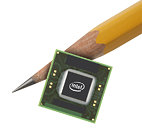
Intel Thunderbolt Technology Turns 10
In 2011, computers were clogged with too many input/output (I/O) ports. There were USB ports for data; Ethernet ports for internet; and DisplayPort, HDMI and VGA ports for video. Despite being large enough to accommodate multiple ports, the computers still couldn't keep up with users' needs.
The solution? Intel launched Thunderbolt technology, which consolidated data, video and power on a single, small connector. Thunderbolt allowed users to move data quickly and confidently among connected smart devices - like PCs, docks, monitors, solid state drives, external hard drives and cameras - using that single connector. At the time, Thunderbolt boasted the ability to transfer a full-length, high-definition movie in less than 30 seconds and back up a full year of continuous MP3 music playback in just over 10 minutes.
The solution? Intel launched Thunderbolt technology, which consolidated data, video and power on a single, small connector. Thunderbolt allowed users to move data quickly and confidently among connected smart devices - like PCs, docks, monitors, solid state drives, external hard drives and cameras - using that single connector. At the time, Thunderbolt boasted the ability to transfer a full-length, high-definition movie in less than 30 seconds and back up a full year of continuous MP3 music playback in just over 10 minutes.












